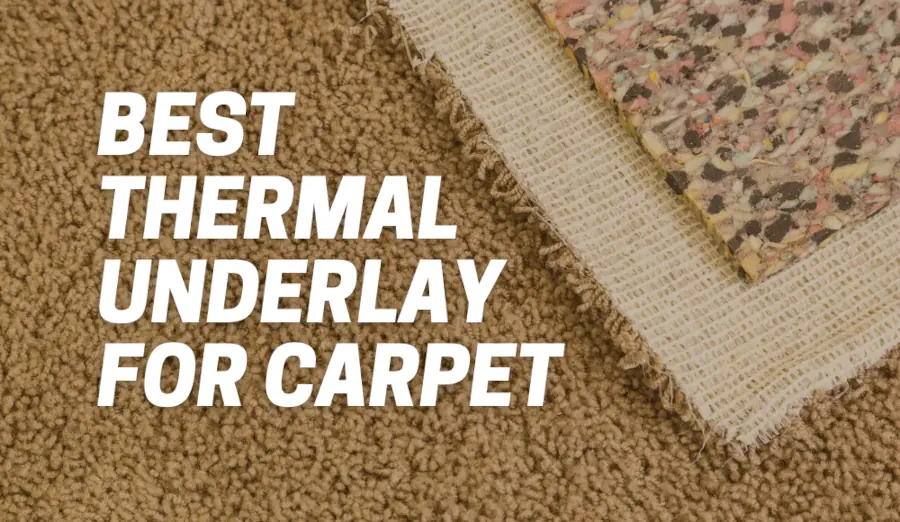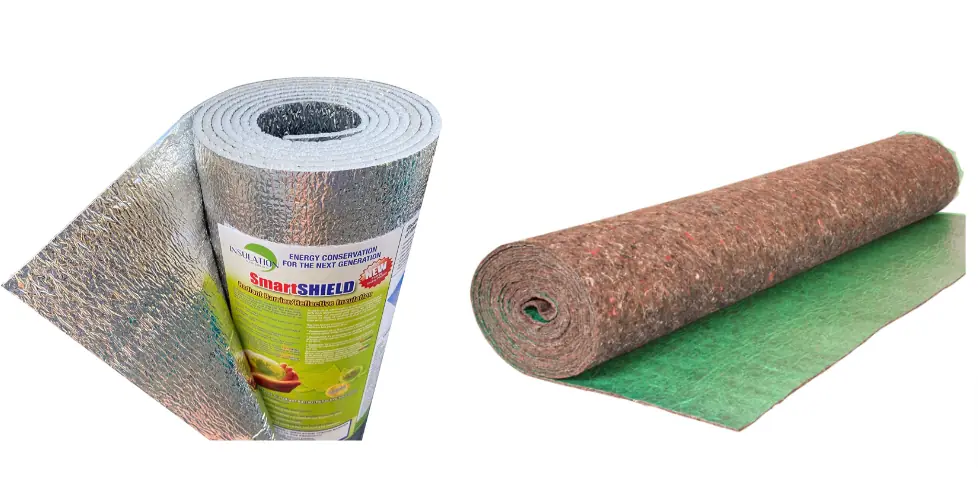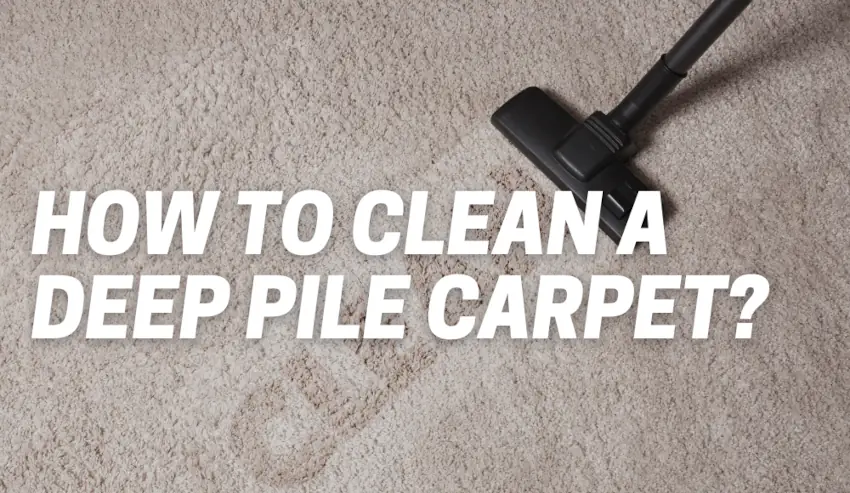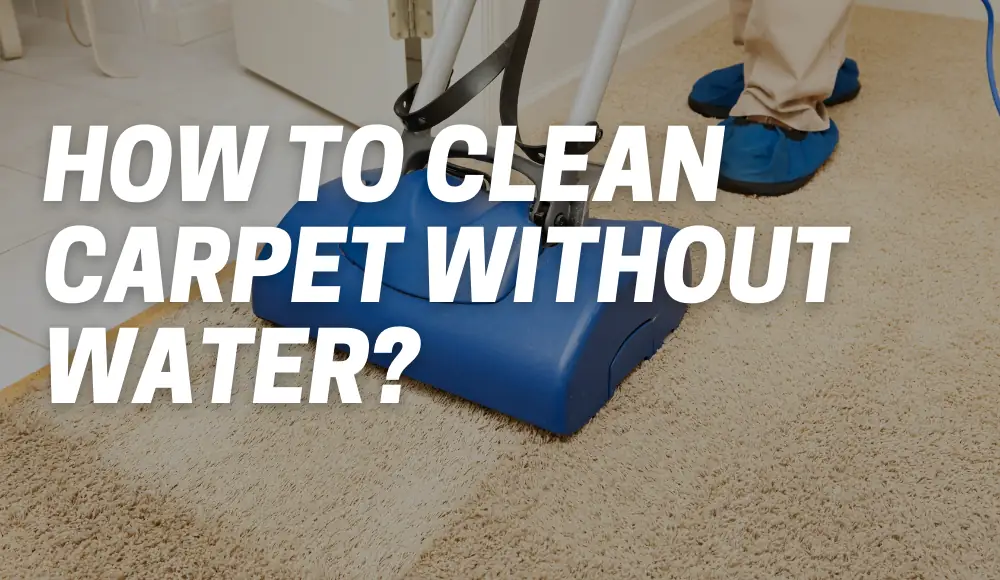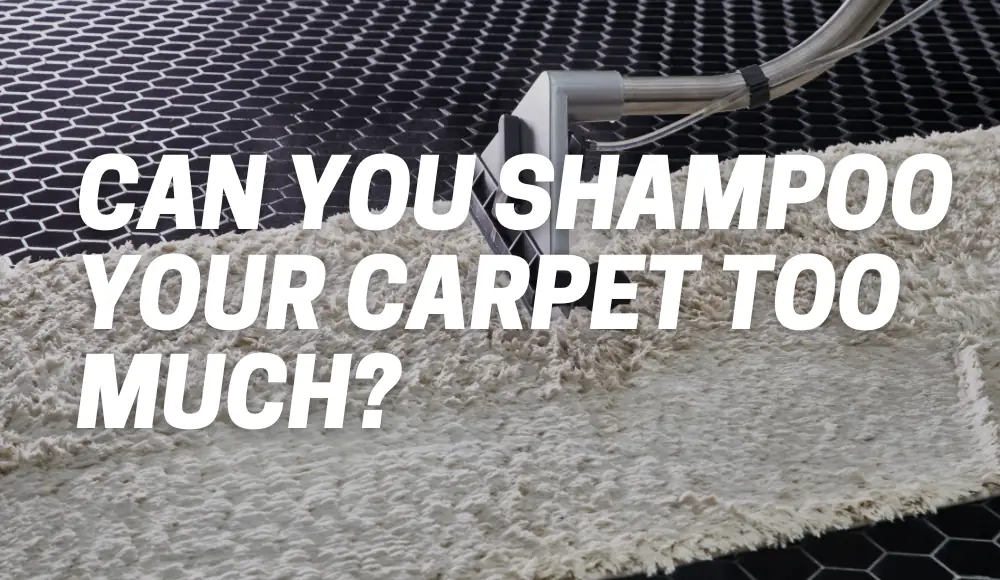If you’re looking to add an extra layer of comfort and warmth to your home, thermal underlay for carpets might just be the solution you need. This innovative product is designed to provide insulation and enhance the thermal efficiency of your flooring, making it perfect for those chilly winter months. But how does thermal underlay work, and what should you consider when choosing the best thermal underlay for carpet in your home?
Let’s dive in and explore the world of thermal underlay.
The Benefits of Using a Thermal Underlay
Increased Insulation and Energy Efficiency
When installing carpet in your home, you’ll want to ensure that it is as energy efficient as possible. One way to do this is by using a thermal underlay.
A thermal underlay will help insulate your home, keeping warm air inside during the winter months and cool air inside during the summer months.
This increased insulation can help reduce your energy bills by up to 15% because you won’t need to use as much heating or cooling to maintain a comfortable temperature.
Reduced Noise Transmission
Carpet can be noisy, especially if you have kids or pets running around. A thermal underlay can help reduce noise transmission from room to room, making your home quieter and more peaceful.
The extra padding provided by the underlay absorbs sound waves and prevents them from traveling through the floor.
Improved Comfort Underfoot
Walking on a hard floor can be uncomfortable, especially if you stand for long periods of time. A thermal underlay provides an extra layer of padding between your feet and the floor, improving comfort levels significantly.
The cushioning effect will make walking around your home feel like you’re walking on clouds!
Additionally, if someone in your household has joint pain or suffers from arthritis, they’ll appreciate the added comfort that a thermal underlay provides when walking around barefoot. Using a thermal underlay for carpet installation has many benefits beyond simply providing extra cushioning beneath your feet.
It increases insulation and energy efficiency while reducing noise transmission throughout your home. So why not invest in one today?
Is there Thermal Underlay for Carpets?
First things first.
Yes, there is thermal underlay specifically designed for carpets. While many people are familiar with underlay for laminate or hardwood floors, thermal underlay for carpets has gained popularity in recent years.
It is a specialized type of underlay that focuses on providing insulation and heat retention, allowing you to enjoy a cozier and more energy-efficient environment.
Factors to consider when choosing a thermal underlay
Thickness and Density
One of the most important factors to consider when choosing a thermal underlay is thickness and density. The thicker and denser the underlay, the better it will be at insulating your home against heat loss.
A dense underlay will also provide more support for your carpet, making it more comfortable to walk on. However, you don’t want to go too thick or too dense as this can make installation difficult and increase the risk of mold growth if moisture seeps through.
Moisture Resistance
Moisture resistance is another crucial factor to take into account when selecting a thermal underlay.
A damp carpet can be an ideal breeding ground for mold and mildew, which can lead to serious health issues for people with allergies or respiratory problems.
Therefore, it’s essential to choose an underlay that has good moisture resistance properties. Rubber is a good option due to its non-porous nature, while foam tends to be more porous but can still offer decent moisture protection.
Compatibility with Carpet Type
You need to ensure that the thermal underlay you choose is compatible with the type of carpet you’re installing. Some materials are more suitable for certain types of carpet than others due to their density or thickness.
For example, a high-density rubber underlay may not be suitable for low-pile carpets as it could make them feel too firm underfoot. Similarly, a thin foam pad may not provide enough support for thick pile carpets as they will quickly compress over time leaving your carpet unsupported.
Does Thermal Underlay Work?
Absolutely! Thermal underlay works by creating a barrier between your carpet and the subfloor.
This barrier helps to prevent heat loss through the floor, effectively trapping warmth and keeping it within your living space. By reducing heat transfer, thermal underlay can make your carpeted floors feel significantly warmer and more comfortable to walk on.
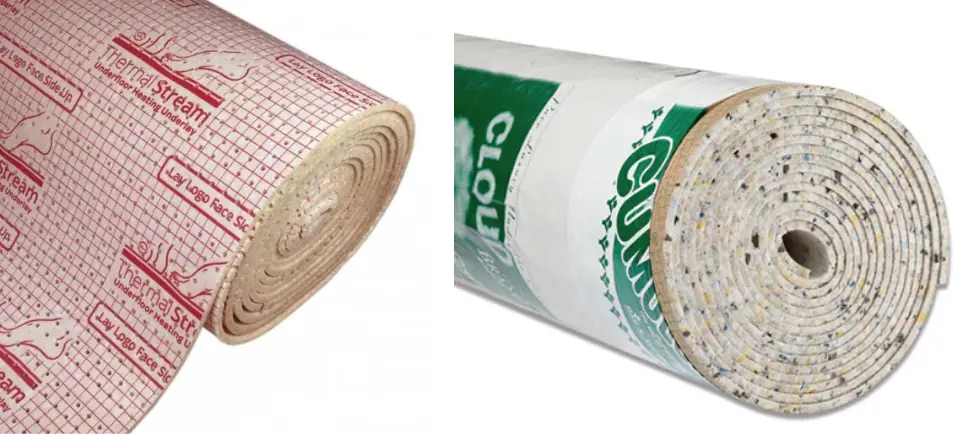
What is the Warmest Carpet Underlay?
When it comes to finding the warmest carpet underlay, there are a few factors to consider.
One crucial aspect is the material used in the underlay. Some of the best options for maximum warmth include rubber, foam, and felt underlays. These materials offer excellent insulation properties and help retain heat effectively.
Additionally, the thickness of the underlay plays a role in its warmth. Thicker underlays tend to provide better insulation, as they create a more substantial barrier against heat loss.
However, keep in mind that the overall thickness should be appropriate for your specific carpet and the requirements of your room.
What is the Best Thickness for Carpet Underlay?
The best thickness for carpet underlay depends on various factors, including the type of carpet and the specific needs of your space.
Carpet underlays typically boast a greater thickness compared to those used with laminate flooring, resulting in a higher tog rating. This is due to their inherent insulation properties, providing enhanced thermal insulation.
As a general guideline, a thickness of around 8mm to 10mm is considered suitable for most residential applications. This thickness strikes a balance between comfort, durability, and effective insulation.
However, if you’re looking for enhanced thermal performance, you might consider opting for a thicker underlay. Thicker options, such as 10mm to 12mm, can provide better heat retention and insulation properties.
Always consult with professionals or refer to the manufacturer’s guidelines to ensure you choose the appropriate thickness for your specific carpet and room requirements.
Is 8 lb Carpet Padding Better Than 5 lb?
Carpet padding, also known as carpet cushion or underlay, comes in various densities. The density is measured in pounds per cubic foot (lb/ft³), indicating how much weight a cubic foot of padding can support.
When comparing an 8 lb carpet padding to a 5 lb carpet padding, the higher density of the 8 lb padding generally indicates better quality and durability.
From an insulation standpoint, both 8 lb and 5 lb carpet paddings can offer reasonable thermal properties. However, the higher density of 8 lb padding often translates to better support, prolonged carpet life, and improved sound absorption. Therefore, if you’re looking for a more durable and long-lasting solution, 8 lb carpet padding is typically the preferred choice.
What is the Highest R-Value Carpet Underpad?
R-value (insulation) serves as a gauge of how well insulation can withstand heat flow. A higher R-Value indicates superior thermal efficiency and insulation performance.
The R-value measures the thermal resistance of a material. The higher the R-value, the better the insulation performance.
When it comes to carpet underlay, the highest R-value options are generally those made from denser materials like rubber or foam.
While specific R-values may vary depending on the manufacturer and underlay type, you can typically find carpet underpads with R-values ranging from 1.0 to 2.0. These values indicate a moderate to high level of thermal resistance, helping to keep your floors warmer and more comfortable.
What Underlay Has High Thermal Resistance?
When seeking underlay with high thermal resistance, look for materials like rubber or foam.
- Rubber underlay, for instance, is known for its excellent insulation properties, providing a high level of thermal resistance.
- Foam underlay, especially those made from high-density materials, can also offer significant thermal resistance and help retain heat effectively.
To ensure you’re selecting an underlay with high thermal resistance, look for product specifications that highlight its insulation properties or R-values. This information can guide you in choosing the most suitable option for your needs.
Best Thermal Underlay for Carpet
With various options available, determining what is the best thermal insulation type for carpet depends on your specific requirements.
However, some highly recommended choices include rubber underlay, foam underlay, and felt underlay. These materials have proven to provide excellent insulation, warmth, and comfort, ensuring an enhanced experience for you and your family.
When selecting the best thermal underlay, consider factors such as material, thickness, and insulation properties. Assess the needs of your space, the type of carpet you have, and any specific requirements you may have, such as sound absorption or moisture resistance. Taking these aspects into account will help you make an informed decision and find the ideal thermal underlay for your carpet.
What is the Best Carpet Underlay for a Cold Concrete Floor?
If you have a cold concrete floor, it’s crucial to choose an underlay that offers both insulation and moisture resistance.
In this case, rubber underlay is an excellent choice. Rubber is known for its exceptional thermal insulation properties, and it can effectively prevent the transfer of cold from the concrete to your carpeted floor.
Furthermore, rubber underlay provides a moisture barrier, which is essential when dealing with concrete floors. It helps protect your carpet from potential moisture damage, such as mold or mildew growth, while simultaneously adding warmth and comfort to your space.
Installation Tips for Thermal Underlays
Properly Measure the Room and Cut the Underlay Accordingly
When installing a thermal underlay for your carpet, it is important to measure the room properly. This will ensure that you purchase the right amount of underlay for your space.
Use a tape measure to calculate the length and width of your room, and then multiply these numbers together to determine the total square footage.
Once you have this measurement, you can purchase enough underlay to cover the entire area. Once you have purchased your thermal underlay, it’s important to cut it according to the measurements of your room.
Use a sharp utility knife or pair of scissors to trim any excess material. It’s best to leave a small gap between the underlay and walls or obstacles in order to avoid any potential buckling or creasing during installation.
Ensure the Seams Are Properly Sealed To Prevent Air Leakage
Sealing seams is an essential step in proper thermal underlay installation. If seams are not sealed correctly, air can leak through and reduce overall insulation efficiency. In order to seal seams, use strong adhesive tape designed specifically for this purpose.
To begin, place two strips of tape parallel from one another along each piece of underlay which will be joined together on their edges (seam).
Then fold one half over so that it sits neatly alongside its adjacent section without overlapping onto its surface area yet – press down firmly at both ends where they meet before peeling off the backing paper from the second strip before carefully pressing down again onto the first (sticky) strip without any wrinkles forming beneath as this process ensures optimal insulation performance over time!
Frequently Asked Questions
What is the most thermally efficient underlay?
Rubber and foam underlays are considered some of the most thermally efficient options due to their excellent insulation properties and high thermal resistance.
What is the warmest carpet?
When it comes to the warmest carpet, there are several factors to consider.
The warmth of a carpet depends on its material, construction, and the type of underlay used. Here are a few options known for their warmth:
- Wool Carpet: Wool is a natural fiber that offers excellent insulation and warmth. It has natural thermal properties that help retain heat and create a cozy atmosphere.
- Frieze Carpet: Frieze carpet, also known as shag carpet, consists of long, twisted fibers that provide a plush and warm underfoot feel. The dense construction helps trap heat and maintain a comfortable temperature.
- Berber Carpet: Berber carpets feature a looped construction, typically made from wool or synthetic fibers. The tightly woven loops help retain warmth and create a cozy ambiance.
- Cut and Loop Carpet: This type of carpet combines both cut and looped fibers, resulting in a textured surface. The varied pile heights and densities contribute to improved insulation and warmth.
Remember, the warmth of a carpet is also influenced by the underlay used beneath it. Choosing a high-quality thermal underlay can further enhance the warmth and comfort of your carpeted floors.
What is the best thermal floor?
The best thermal floor depends on your specific needs and preferences. However, options like carpet, cork, or engineered wood can provide good thermal insulation and comfort.
In conclusion, when it comes to enhancing the comfort and warmth of your carpeted floors, thermal underlay is a fantastic investment.
By choosing the right material, thickness, and insulation properties, you can significantly improve the thermal efficiency of your space. Whether it’s rubber, foam, or felt underlay, find the best option that suits your needs, and enjoy the cozy atmosphere all year round.
